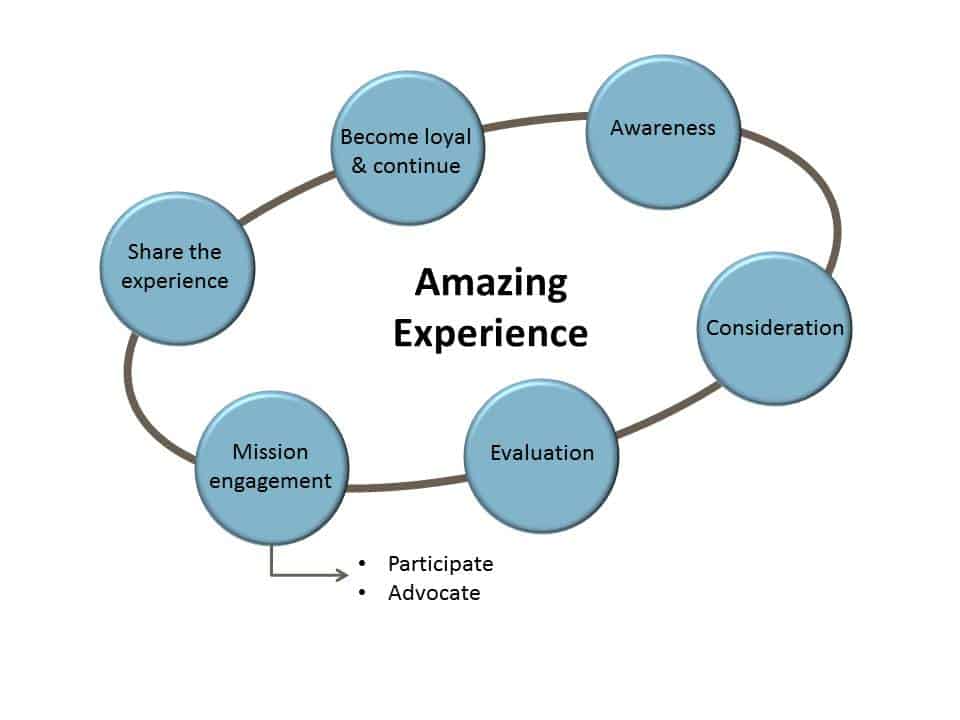
We have all experienced bad customer service. Now with Twitter, we witness our friends’ bad customer service experiences, too. Frustrating and infuriating for the customer, bad customer service can also ruin a brand. And, unfortunately, it isn’t unique to the for-profit world. I have heard stories from friends about bad customer service from nonprofits, too – forgetting to send thank you notes or donor receipts, asking for donations too many times in too many ways or sending dreaded email spam. To address these issues, the for-profit space is moving away from thinking of the customer experience as a single transaction, but instead as a relationship in which customers have multiple experiences with their company.
This notion is even more important for nonprofits where our customers can wear many hats – donor, client, volunteer, advocate and community stakeholder. To this end, nonprofits are in the customer service business, which requires a more sophisticated model than the simple transactional experience. To explore how this issue affects the social sector, I have invited an expert on nonprofit customer engagement, Michael Wilson, to share his knowledge with us. He is Partner and Global Nonprofit Practice Leader for Fortium Partners and author of “The Digital Nonprofit: A Manifesto.” In this guest blog below, he presents new thinking and immediate and inexpensive ways to get started on this important topic of keeping customers satisfied. If you want to go deeper, he is offering a FREE eVersion (PDF) of the book “Digital Business Transformation in a Customer Obsessed World” to our readers.
Customer engagement is a very dynamic and ever-evolving journey. Drawing on several fields of study, customer engagement primarily centers on understanding customer behaviors. How you interpret and respond to these behavior patterns will shape the journey you hope your customers take with your mission. Research has shown that the engagement path is not a linear one, but rather an elliptical one. It is not limited to a single interaction; instead, it includes all of the touch points that an organization has with a customer. The path is shaped in a positive or negative way by the customer’s overall experience. And, there are many specific factors, strategies, people, communities and resources that influence engagement and loyalty along the way.
As you think about someone taking a journey with your mission, you might envision moments where they become aware, start considering your organization, decide to evaluate it, become engaged in some aspect of your mission and become loyal. The experience at each stage influences the connected customer to continue on the journey or opt out altogether. Continuing on through multiple cycles creates greater engagement – customers who advocate or decide to serve on the board. Each loop through the cycle creates a level of loyalty that is harder to break than the previous one. Customers who opt out after one loop through a cycle probably did so due to a bad experience at one or more points in the first journey.
There is a stunning yet simple truth about the connected customer: the connected customer’s experience is not limited to his or her own. In the age of social media, where one customer’s experience can be shared with thousands instantaneously, the power of shared experiences is amplified. These experiences, good or bad, shared via social media or traditionally, influence the path as well, and can affect decisions made by potential customers who may be considering the same journey.
Because the customer experience is so dynamic, it can be challenging to figure out where to start. Here are some ideas on how to help keep your customers engaged:
- Call lost customers – Every month have your executives, or as many people in your organization you can, call at least five customers who have left you. Don’t have a script. Nothing is really required other than the ability to really listen. Create a summary to share results.
- Call loyal customers – We often focus on lost customers, but it is also important to know what you do right and keep doing it. Create a summary to share results.
- Be a customer – Ask everyone in your organization to do one thing you require your customers to do once a month. Create a summary to share results.
- Connect with the frontline – Bring in people from all the frontline operations and give them an opportunity to talk candidly with the CEO about customer challenges.
- Do customer math – Talk about lost and gained customers in every meeting you can. Relate the loss or gain to customer experience issues you are aware of, to what the frontline is saying and to what you experienced as a customer yourself.
We hope this new thinking on customer service will make the engagement process clearer for your organization and we would love to know what works for you. In business school, we were taught that it is easier and cheaper to keep existing customers happy than to acquire new customers. I think this is even truer in the nonprofit space – we need our customers to feel connected to our organization and mission and to recruit others to join the movement.

